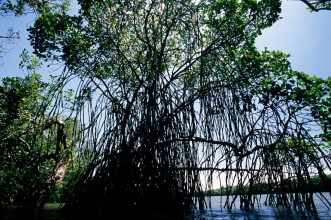Certain mangrove species can propagate successfully in marine environment because of special adaptions. Embryo germination begins on the tree itself, a process called “viviparity”. The tree later drops its its developed embryos, called propagules, which may take root in the soil beneath. Viviparity may have evolved as an adaptive mechanism to prepare the propagules for long-distance dispersal, and survival and growth within a harsh saline environment. During this viviparous development, the propagules and nourished on the parent tree, thus accumulating the carbohydrates and other compounds required for later autonomous growth.
Propagules may float for extended periods (depenting on the species), up to a year, adn still remain viable. Viviparity and the long-lived propagules allow mangrove species to disperse over wide areas. 